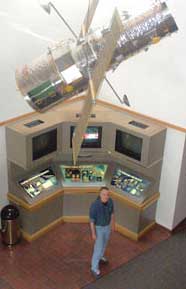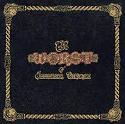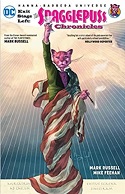There’s a kind of primitive variable that probably everyone who writes computer code knows and understands these days…the Boolean. Unlike other variables which can hold a range of values, be they numbers, or strings of ascii characters, the Boolean is a relentlessly either-or variable. And for that reason, it maps pretty well to the fundamental logic by which all digital computers operate, and to their smallest unit of data, the bit. But humans have been considering their world in Boolean logic ever since our minds first emerged from out of the biological background noise.
Yes-No. True-False. Right-Wrong. Good-Bad. Even as we admit to ourselves that there are often only shades of gray, we persist in reducing our experiences to these terms. It’s as basic an evaluation as can be. The second postulate of Aristotelian logic is that of ‘either-or’. A thing cannot both be, and at the same time not be. Either yes, or no. Either true, or false. Either right, or wrong. Either it is, or it is not. It must be one or the other.
Well…tell it to Schrodinger’s cat. It’s probably no coincidence that our machines are made in our image, that they resemble the way our minds like to think. The canvas always speaks of the artist. But as it turns out, that’s not actually the way our brains operate. It may not even be the way nature, at its most elemental level, works. There’s this intriguing tri-position logic in the natural world that I keep seeing raise its hand and wave at us from time to time. But it seems to go unexamined most of the time, and I think that’s because like the extra space-time dimensions physicists keep telling us are there, it’s hard for our minds to wrap themselves around it. And that’s really interesting, because one place you really see this tri-position logic is in how our brains actually physically work.
Consider the humble synapse. It is the gap between brain cells, across which two different kinds of chemical "messages" can cross. One kind of chemical causes the cell on the other side of the gap to fire. The other chemical inhibits the cell on the other side of the gap from firing. So far, so good. We’re still comfortably in the basic Boolean logic of things. Fire-Don’t fire. Yes-No. Off-On. Either-Or. But there’s a third thing that synapse can do: Nothing.
So synapse logic has three states, not two. Fire, don’t fire, and…what? Here’s where it gets interesting for me. What is the word here. We don’t really have one. And that I think, is because the concept is difficult for us. The state itself seems foreign enough to the way our minds naturally work, that as far as I know, humans don’t really have a good enough word for that third position. Neutral doesn’t quite do it. It isn’t that it isn’t engaged, like a gear shift you put into neutral, say. It’s connected, to the rest of the brain. ‘Off’ isn’t quite it either. Each half of the synaptic gap has a current state that influences the state of the cells on either side of the synaptic gap depending on the direction of the message, or the absence of one. So there are really three states possible here: Fire, don’t fire, and a third, that is neither fire or don’t fire. Depending on the state of the synapses it’s connected to, a brain cell may or may not fire. So the cell itself may have just two states. But the synapses have three.
Our minds just don’t seem to grasp that third logical state very well, and we fumble to describe it. It’s a between state. No…it’s a middle state. Wait…a transitional state… Uhm… No…it’s…it’s… (shrug) I dunno…
Maybe ‘zero’ is the right way to think about it. But I can only say that because I write software code and I understand how zero is actually something distinct from a positive value, is distinct from a negative value. But that seems to be a non-intuitive concept for us humans. Consider that the Arabic invention of the zero as a form of notation actually came well after a lot of other very basic mathematical concepts. Well of course everyone knew that you can have a zero quantity. But expressing it abstractly seemed to be a difficulty. And in many programming languages, 0 evaluates to false anyway, and any other value is true (except in Basic, where –1 is (was) true, which I think is right from a bitwise NOT sense…but don’t get me started…). And…this third position isn’t really a ‘nothing’. It’s more of a ‘neither’.
Another place you see this tri-position logic is natural selection. In the grand scheme of things, the winners are those organisms that are best adapted to their environment. Variation then, that gives an organism an advantage tends to be passed on, and variation that puts an organism at a disadvantage tends not to be passed on. Over time the advantages accumulate, and the disadvantages get culled out. Either-Or. But there is a third thing that can happen. Nothing. A variation can simply be neither an advantage nor a disadvantage. Those variations it seems, get placed in the genetic portfolio right along with the advantages too…
Landmark study prompts rethink of genetic code
The most detailed probe yet into the workings of the human genome has led scientists to conclude that a cornerstone concept about the chemical code for life is badly flawed.
The ground-breaking study, published in more than two dozen papers in journals on both sides of the Atlantic, takes a small percentage of the genome to pieces to draw up a "parts list," identifying the biological role of every component.
For the international team of investigators, the four-year project was the computer-equivalent of passing a fine-toothed comb through a mountain of raw data.
Reporting in the British journal Nature and the US journal Genome Research on Thursday, they suggest that an established theory about the genome should be consigned to history.
Under this view, the genome is rather like a ribbon studded with some 22,000 "nuggets" in the form of genes, which make proteins, the essential stuff of life.
Genes — deemed so valuable that some discoverers of them have been prompted to file patents over them for commercial gain — amount to only around a twentieth, or even less, of the genetic code.
In between the genes and the sequences known to regulate their activity are long, tedious stretches that appear to do nothing. The term for them is "junk" DNA, reflecting the presumption that they are merely driftwood from our evolutionary past and have no biological function.
But the work by the ENCODE (ENCyclopaedia of DNA Elements) consortium implies that this nuggets-and-dross concept of DNA should be, well, junked.
The genome turns out to a highly complex, interwoven machine with very few inactive stretches, the researchers report.
Genes, it transpires, are just one of many types of DNA sequences that have a functional role.
And "junk" DNA turns out to have an essential role in regulating the protein-making business.
Previously written off as silent, it emerges as a singer with its own discreet voice, part of a vast, interacting molecular choir.
"The majority of the genome is copied, or transcribed, into RNA, which is the active molecule in our cells, relaying information from the archival DNA to the cellular machinery," said Tim Hubbard of the Wellcome Trust Sanger Institute, a British research group that was part of the team.
"This is a remarkable finding, since most prior research suggested only a fraction of the genome was transcribed."
Francis Collins, director of the US National Human Genome Research Institute (NHGRI), which coralled 35 scientific groups from around the world into the ENCODE project, said the scientific community "will need to rethink some long-held views about what genes are and what they do."
"This could have significant implications for efforts to identify the DNA sequences involved in many human diseases," he said.
Another rethink is in offing about how the genome has evolved, said Collins.
Until now, researchers had thought that the pressure to survive would relentlessly sculpt the human genome, leaving it with a slim, efficient core of genes that are essential for biological function.
But the ENCODE consortium were surprised to find that the genome appears to be stuffed with functional elements that offer no identifiable benefits in terms of survival or reproduction.
The researchers speculate that there is a point behind this survival of the evolutionary cull. Humans could share with other animals a large pool of functional elements — a "warehouse" stuffed with a variety of tools on which each species can draw, enabling it to adapt according to its environmental niche.
IMO, there’s that third logical position at work again. The variation is neither good, nor bad, it’s just there. At some future point, say a rapid change in the organism’s environment, and that gene might be a handy thing to have all of a sudden. Or, conversely, it might turn into a complete disaster for the organism. But for the moment, it’s just there, evaluated to position three. Zero, let’s say. Neither positive nor negative. It has the potential to be either one, given a chance to express itself.
From somewhere deep in the physical fabric of the universe, Schrodinger’s cat licks its chops and smiles. Or doesn’t. Or both. Just don’t open the box.
The science fiction writer Larry Niven once averred that giving gay people what we want would be the quickest way of breeding us out of the population. But then, he didn’t get the fact that his Ringworld needed attitude jets until some real engineers pointed that fact out to him. I happen to think that having a gay minority does in fact provide a survival advantage to the human line. But as it turns out, homosexuality can fit comfortably into our gene pool just fine, along with a bazillion other random variations on a theme that simply are, and do no harm.
I don’t need to pass on my gay genes. My heterosexual brethren probably have them too…they just aren’t expressing them. For some reason, I expressed mine. But I’m fine with that, and so is nature. I happen to think it’s a plus. But the point is that a variation only gets culled out if it’s a minus. A really big minus. And this one isn’t.
[Edited a tad…]







































